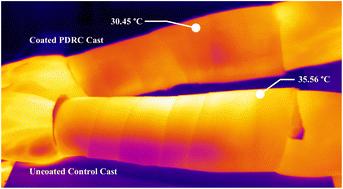生物相容性被动辐射冷却快速固化玻璃纤维铸件
IF 9.5
2区 材料科学
Q1 CHEMISTRY, PHYSICAL
引用次数: 0
摘要
被动日间辐射冷却(PDRC)提供了一种零能量的方法,通过反射太阳辐射并通过中红外大气窗口发射热能来降低地表温度。然而,许多高性能PDRC材料需要刚性或脆性衬底,限制了它们在柔性或弯曲表面上的应用。在这里,我们报告了一种双层PDRC涂层集成到商业玻璃纤维铸件上,这是一种快速固化,机械坚固的基材,通常用于骨科支撑。该涂层由聚乙烯醇(PVA)粘附层和聚甲基丙烯酸甲酯(PMMA)顶层组成,两者都嵌入了从动物骨废物中提取的焦磷酸钙(CPP)陶瓷颗粒。CPP可实现宽带太阳反射率和强中红外发射率,同时也有助于可持续性和生物相容性。该涂层可实现90%以上的太阳反射率,并在阳光直射下提供高达15°C的亚环境冷却。它在环境压力下保持稳定性,表现出耐水性(接触角~ 85°)、紫外线耐久性、耐磨性和超过650°C的热稳定性。机械测试证实在不影响结构强度的情况下增强了柔韧性。这项工作展示了一种可扩展的、可现场部署的PDRC平台,适用于可穿戴冷却、骨科舒适和移动热调节。本文章由计算机程序翻译,如有差异,请以英文原文为准。

Biocompatible passive radiative cooling rapid-curing fiberglass casts
Passive daytime radiative cooling (PDRC) provides a zero-energy approach to reducing surface temperatures by reflecting solar radiation and emitting thermal energy through the mid-infrared atmospheric window. However, many high-performance PDRC materials require rigid or brittle substrates, limiting their application on flexible or curved surfaces. Here, we report a bilayer PDRC coating integrated onto a commercial fiberglass cast, a fast-curing, mechanically robust substrate commonly used for orthopedic support. The coating consists of a polyvinyl alcohol (PVA) adhesion layer and a polymethyl methacrylate (PMMA) top layer, both embedded with calcium pyrophosphate (CPP) ceramic particles derived from animal bone waste. CPP enables broadband solar reflectance and strong mid-infrared emittance while also contributing to sustainability and biocompatibility. The coating achieves over 90% solar reflectance and delivers up to 15 °C sub-ambient cooling under direct sunlight. It maintains stability under environmental stress, showing water resistance (contact angle ∼85°), UV durability, abrasion tolerance, and thermal stability exceeding 650 °C. Mechanical tests confirm enhanced flexibility without compromising structural strength. This work demonstrates a scalable, field-deployable PDRC platform suitable for wearable cooling, orthopedic comfort, and mobile thermal regulation.
求助全文
通过发布文献求助,成功后即可免费获取论文全文。
去求助
来源期刊

Journal of Materials Chemistry A
CHEMISTRY, PHYSICAL-ENERGY & FUELS
CiteScore
19.50
自引率
5.00%
发文量
1892
审稿时长
1.5 months
期刊介绍:
The Journal of Materials Chemistry A, B & C covers a wide range of high-quality studies in the field of materials chemistry, with each section focusing on specific applications of the materials studied. Journal of Materials Chemistry A emphasizes applications in energy and sustainability, including topics such as artificial photosynthesis, batteries, and fuel cells. Journal of Materials Chemistry B focuses on applications in biology and medicine, while Journal of Materials Chemistry C covers applications in optical, magnetic, and electronic devices. Example topic areas within the scope of Journal of Materials Chemistry A include catalysis, green/sustainable materials, sensors, and water treatment, among others.
 求助内容:
求助内容: 应助结果提醒方式:
应助结果提醒方式:


